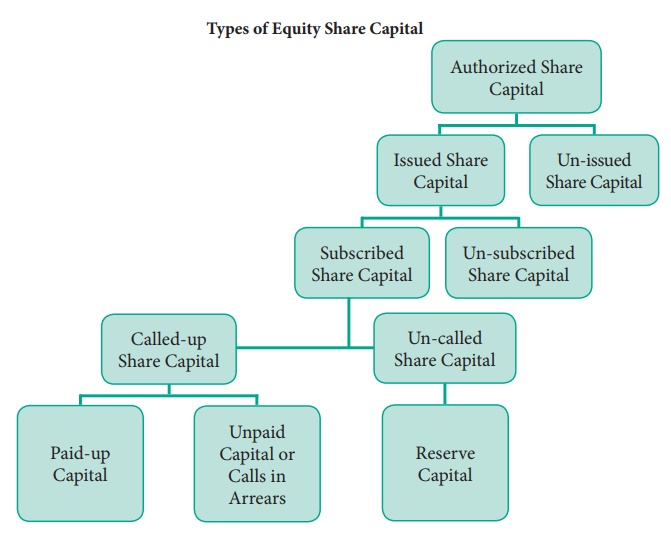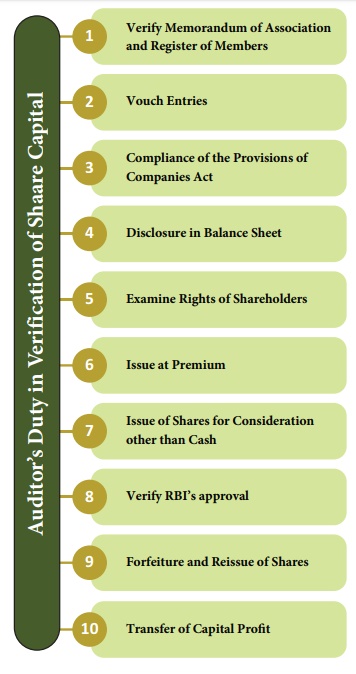Auditing - Verification of Capital | 12th Auditing : Chapter 6 : Verification of Liabilities
Chapter: 12th Auditing : Chapter 6 : Verification of Liabilities
Verification of Capital
Verification of Capital
The
amount invested by the owner in a business concern is called as Capital. The
owner may be a sole proprietor or partner or shareholder. It is an internal
liability of the business concern and the auditor is required to verify the
genuiness and correctness of it in the Balance Sheet.
1. Verification of Capital in a Partnership Firm
The
auditor should take into consideration the following while verifying capital of
a partnership firm.
Verify Partnership Deed:
The
auditor should verify the partnership deed to find out the original capital
contributed by each partner and the rate of interest payable on capital.
Verify Capital Accounts:
He
should verify all the transactions affecting the capital accounts of the
partner.
Examine Books of Accounts:
He
should examine the cash book, pass book and withdrawals of the partner.
2. Verification of Capital in a Company
While
verifying the capital of a company, the auditor should verify the share capital

Meaning of Share Capital
Share
capital means the capital raised by issue of shares. It is the amount invested
by shareholders towards the face value of shares are collectively known as
Share Capital.
Types of Equity Share Capital
Authorised Capital: It is
the maximum amount of capital which
a company is authorised to raise and is stated in the Memorandum of
Association. It can also be called as ŌĆ£Registered CapitalŌĆØ or ŌĆ£Nominal
CapitalŌĆØ.
Issued Capital: This represents a part of the authorized capital, which is
issued to public for subscription.
Unissued Capital: The difference between authorised capital and the
issued capital represents unissued capital.
Subscribed Capital: It refers
to that part of the issued capital
which has been subscribed by the public.
Unsubscribed Capital: The
difference between issued capital
and subscribed capital represents unsubscribed capital.
Called-up Capital: This refers to that part of the subscribed capital which
has been called up by the company for payment.
Un-called Capital: The difference between subscribed and called-up capital is
called un-called capital.
Paid-up Capital: It is that part of called-up capital which has been
actually paid-up by shareholders.
Unpaid Capital: The un-paid balance in the called-up capital

Reserve Capital: A company can reserve part of its un-called capital and will
be called only at the time of winding up. A special resolution has to be passed
for this purpose. It is not disclosed in the companyŌĆÖs balance sheet.
Auditor's Duty in Verification of Share Capital
The
auditorŌĆÖs role in verifying the Share Capital is listed below:
1. Verify Memorandum of Association and
Register of Members: In case of
first audit the auditor should check the Memorandum of Association, list of
share holders and register of members for verification of share capital.
2. Vouch Entries: He should examine the pass book, cash book, and Minute
book of directors in order to find out the number of shares issued, different
types of shares issued and the amount received on each shares.
3. Compliance with the Provisions of Companies
Act: In case of subsequent audits,
the auditor should ensure that share capital balance is the same as at the end
of last year. If he finds that the capital stands altered by fresh issue of
shares, the auditor should ensure that relevant provisions of the Companies Act
have been complied with.
4. Disclosure in Balance Sheet: He
should ensure that ŌĆśauthorised
capitalŌĆÖ and each class of issued and subscribed capital has been shown
separately in the Balance Sheet.
5. Examine Rights of Shareholders: He should examine the rights attached to
various shares in the Articles of the company.
6. Issue at Premium: Where the shares are
issued at premium, he should verify that they are shown separately in the
Balance Sheet.
7. Issue of Shares for Consideration other than Cash: Where the shares were allotted for consideration other
than cash, he
should examine the contract constituting with the vendor
share and minutes book of the board.
8. Verify RBIŌĆÖs Approval: Where shares are
allotted to foreign nationals, the auditor should verify RBI's permission in
this regard.
9. Forfeiture and Reissue of Shares: The
auditor should ensure that Articles of Association permit for forfeiture shares
of and check the entries regarding forfeiture and reissue of shares.
10. Transfer of Capital Profit: He
should verify that capital profit if
any on reissue of forfeited shares has been transferred to Capital Reserve.
3. Verification of Reserves and Surplus
Meaning
Reserves
and Surplus is that portion of current profits or of accumulated profits which
is not distributed as dividend, but is kept separate for purposes of meeting
some known or unknown liabilities or for fulfillment of future needs.
Auditor's Duty
Reserves
and surplus are appropriation out of profits. The auditor should verify that
the reserves and surplus are

shown on
the liability side of Balance Sheet with footnotes and verify entries in the
Profit and Loss Appropriation Account.
Related Topics